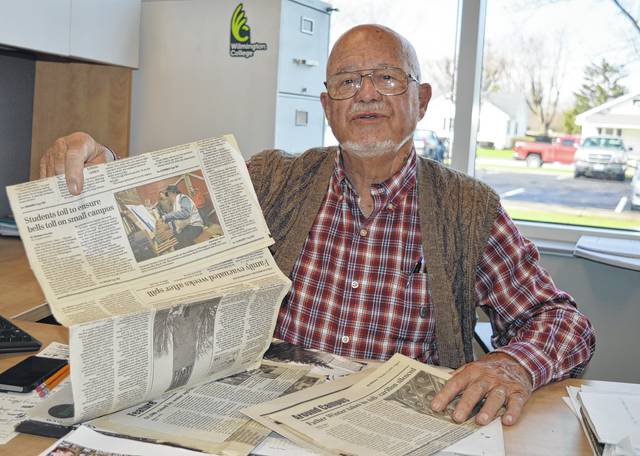
WILMINGTON — Recently retired Wilmington College professor Don Chafin specialized in the economic aspect of agriculture.
“I am not cows and plows and sows. I’m dollar signs,” Chafin said in characteristically colorful fashion.
When he came to WC in 1976, he taught a full load of classes and also served as head of the Agriculture Department and the farm manager. Though a challenging workload, it was doable because at the time there were altogether 36 agriculture students enrolled at the school.
Chafin’s background in agriculture began in Appalachia where he grew up on a general livestock farm among the Blue Ridge Mountains of Virginia.
“I milked cows with Mom to earn money through high school,” said Chafin, who was a state FFA officer in Virginia.
He spent his undergraduate college years at Virginia Tech, to which he commuted with other students from the rural area.
After finishing at Virginia Tech, he wanted to get into “real agriculture,” he recalled for this profile article. “Real agriculture is the Midwest,” Chafin added.
Upon earning a master’s degree at The Ohio State University, he returned to Virginia Tech where he held a post in the Agricultural Economics Department for five years. He then returned to OSU where he received his Ph.D. before moving on to Chicago where he worked for a company managing large farms from Wisconsin to Orlando, Florida.
But that involved a lot of traveling and being away from home. He contacted his OSU adviser Edgar Shaudys, who had been one of WC’s early Aggies and who suggested Wilmington College to Chafin as a place to ply the craft of teaching agriculture.
He liked what he saw at Wilmington College, with 1,000 acres of farmland and students “out there getting dirty and doing things.” The college hired Chafin.
In 1983-84, Chafin was in Ireland on a Fulbright Scholarship, showing them how to do a CAUV-type program. At Ohio State, CAUV had been a project of his major professor, said Chafin, so he got to work on it a lot there.
He said he knows “the innards of CAUV.”
For property tax purposes, farmland devoted exclusively to commercial agriculture may be valued according to its current use rather than at its “highest and best” potential use. This provision of Ohio law is known as the Current Agricultural Use Value (CAUV) program.
Chafin also reflected on the Agricultural Depression of the mid-1980s.
Preceding the farm crisis of the 1980s, ag prices had shot up due to the export market. Earl Butz, who served as U.S. Secretary of Agriculture under Presidents Nixon and Ford, recommended that American farmers plant “fence row to fence row” in response to the big jump in demand, Chafin said.
Furthermore, there was a relaxing in ag lending, and the lending system “fueled that bubble” which later broke, he said.
By the mid-1980s, there was a surplus of production and the price of corn dropped from about $4 to $1.86.
“Fortunately there are enough bankers today who still remember the mid-’80s, and they did not lend near as aggressively in this era we’re in now, so the adjustment isn’t going to be near so severe,” said Chafin.
In addition, the crop insurance and income insurance programs that farmers have become accustomed to are a safety net for farmers so that — if they’re not financially overextended — they can survive, said the educator.
During the 40 years Chafin taught at WC, the college’s agriculture program has changed and adjusted to current farm realities, he said.
In contrast to earlier times, a lot of the contemporary students arrive on campus having never driven a tractor. There are more ag students coming from a suburban or urban upbringing, and who are drawn to agriculture from interests in a healthy food supply or preserving the environment, said Chafin.
Accordingly, the college’s Academic Farm plays a key role for those students who have less of a background in farming or whose experience on a farm is more specialized.
But WC’s commercial farmland is still critically important, he added.
“The students make up a fertility plan; they do a soil-testing program, scout for weeds, they do a farm-management plan, a cash-flow plan, and know the accounting,” said Chafin.
Looking ahead to the future of WC’s ag program, he sees the college keeping solid with production farmers who will go back to farms.
But the college will also be serving young people who aren’t expected to end up in production ag. Instead, these students are heading in the direction of allied agricultural fields such as supplying seed, insecticides and herbicides, insurance and credit, accounting, regulatory agencies, and planning and consulting that production farmers need.
There are many young people attracted to agriculture now who did not grow up on a farm or who were not 4-H or FFA members, he said.
“We welcome those people, because they are concerned about the environment, the quality of food, food safety, the adequacy of food, the healthy part of food,” he remarked.
During his WC career, he has most enjoyed watching the transformations that occur during the four-year collegiate period in the young people’s lives.
“If you can inspire them and challenge them to think beyond the box, it’s amazing,” said Chafin, 77.
He feels farmers in southwest Ohio are fortunate in several respects: The winter basis corn market is Cincinnati because the upper Mississippi River freezes; there is a high-fructose plant in Dayton; and there is an ethanol plant in Bloomingburg.
He and his wife Jane hope to travel during retirement. And Don expects to be a contributor to three books on teaching practices.
Chafin plans to continue his side business “Smokey Pig,” selling smoked turkeys and ham.
While his children were growing up, he started a seven-acre, cut-your-own Christmas tree venture, planting about 7,000 trees. He kept that for about 10 holiday seasons.
Reach Gary Huffenberger at 937-556-5768.


